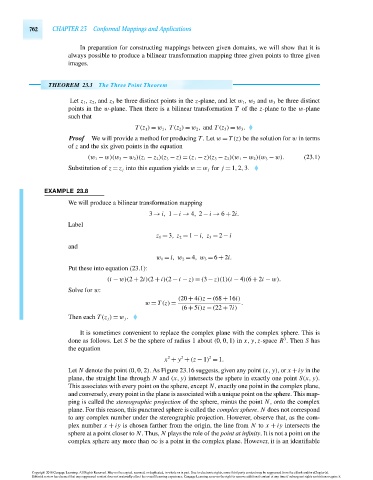Page 782 - Advanced_Engineering_Mathematics o'neil
P. 782
762 CHAPTER 23 Conformal Mappings and Applications
In preparation for constructing mappings between given domains, we will show that it is
always possible to produce a bilinear transformation mapping three given points to three given
images.
THEOREM 23.3 The Three Point Theorem
Let z 1 , z 2 , and z 3 be three distinct points in the z-plane, and let w 1 , w 2 and w 3 be three distinct
points in the w-plane. Then there is a bilinear transformation T of the z-plane to the w-plane
such that
T (z 1 ) = w 1 , T (z 2 ) = w 2 , and T (z 3 ) = w 3 .
Proof We will provide a method for producing T .Let w = T (z) be the solution for w in terms
of z and the six given points in the equation
(w 1 − w)(w 3 − w 2 )(z 1 − z 2 )(z 3 − z) = (z 1 − z)(z 3 − z 2 )(w 1 − w 2 )(w 3 − w). (23.1)
Substitution of z = z j into this equation yields w = w j for j = 1,2,3.
EXAMPLE 23.8
We will produce a bilinear transformation mapping
3 → i, 1 − i → 4, 2 − i → 6 + 2i.
Label
z 1 = 3, z 2 = 1 − i, z 3 = 2 − i
and
w 1 = i,w 2 = 4,w 3 = 6 + 2i.
Put these into equation (23.1):
(i − w)(2 + 2i)(2 + i)(2 − i − z) = (3 − z)(1)(i − 4)(6 + 2i − w).
Solve for w:
(20 + 4i)z − (68 + 16i)
w = T (z) = .
(6 + 5i)z − (22 + 7i)
Then each T (z j ) = w j .
It is sometimes convenient to replace the complex plane with the complex sphere. This is
done as follows. Let S be the sphere of radius 1 about (0,0,1) in x, y, z-space R . Then S has
3
the equation
2
2
2
x + y + (z − 1) = 1.
Let N denote the point (0,0,2). As Figure 23.16 suggests, given any point (x, y),or x +iy in the
plane, the straight line through N and (x, y) intersects the sphere in exactly one point S(x, y).
This associates with every point on the sphere, except N, exactly one point in the complex plane,
and conversely, every point in the plane is associated with a unique point on the sphere. This map-
ping is called the stereographic projection of the sphere, minus the point N, onto the complex
plane. For this reason, this punctured sphere is called the complex sphere. N does not correspond
to any complex number under the stereographic projection. However, observe that, as the com-
plex number x + iy is chosen farther from the origin, the line from N to x + iy intersects the
sphere at a point closer to N. Thus, N plays the role of the point at infinity. It is not a point on the
complex sphere any more than ∞ is a point in the complex plane. However, it is an identifiable
Copyright 2010 Cengage Learning. All Rights Reserved. May not be copied, scanned, or duplicated, in whole or in part. Due to electronic rights, some third party content may be suppressed from the eBook and/or eChapter(s).
Editorial review has deemed that any suppressed content does not materially affect the overall learning experience. Cengage Learning reserves the right to remove additional content at any time if subsequent rights restrictions require it.
October 14, 2010 15:39 THM/NEIL Page-762 27410_23_ch23_p751-788

